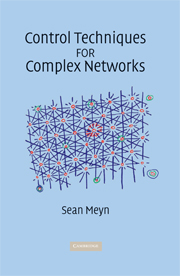2 - Examples
from Part I - Modeling and Control
Published online by Cambridge University Press: 17 March 2011
Summary
In this chapter we introduce many of the modeling and control concepts to be developed in this book through several examples. The examples in this chapter are extremely simple, but are intended to convey key concepts that can be generalized to more complex networks. We will return to each of these examples over the course of the book to illustrate various techniques.
A natural starting point is the single server queue.
Modeling the single server queue
The single server queue illustrated in Fig. 2.1 is a useful model for a range of very different physical systems. The most familiar example is the single-line queue at a bank: Customers arrive to the bank in a random manner, wait until they reach the head of the line, are served according to their needs and the abilities of the teller, and then exit the system. In the single server queue we assume that there is a single line, and only one bank teller. To understand how delays develop in this system we must look at average time requirements of customers and the rate of arrivals to the bank. Also, variability of service times or interarrivals times of customers has a detrimental effect on average delays.
Even in this very simple system there are control and design issues to consider. Is it in the best interest of the bank to reserve a teller to take care of customers with short time requirements?
- Type
- Chapter
- Information
- Control Techniques for Complex Networks , pp. 25 - 51Publisher: Cambridge University PressPrint publication year: 2007

